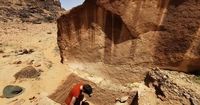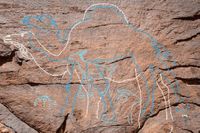In the arid expanse of Saudi Arabia’s Nefud Desert, a discovery has rewritten the story of human resilience and ingenuity in one of the world’s most forbidding landscapes. On September 30, 2025, archaeologists announced the unearthing of three ancient rock art sites—Jebel Arnaan, Jebel Mleiha, and Jebel Misma—each adorned with monumental carvings of camels, aurochs, gazelles, ibex, and wild horses. These life-sized engravings, some standing over two meters high, date back between 11,400 and 12,800 years, pushing back the timeline for human habitation in the region by about 2,000 years. The findings, published in Nature Communications, reveal a vibrant chapter in the Arabian Peninsula’s prehistory, one that speaks of adaptation, artistry, and survival.
According to the research team, the carvings were created during the Pleistocene-Holocene transition—a period when the hyper-arid desert began to experience intermittent wet phases. Seasonal water sources started to appear, transforming the previously inhospitable terrain into a patchwork of lakes and wetlands. As Professor Michael Petraglia of Griffith University explained, “We have a very early date for this rock art, but also a unique date for the human penetration of the heart of Arabia, once environments started to improve.”
But these engravings are more than ancient doodles. They are, as Maria Guagnin from the Max Planck Institute of Geoanthropology described, “statements of presence, access, and cultural identity.” The sheer scale and placement of the carvings—some etched high up on cliff faces, others on narrow ledges—suggest that their creators were both skilled and determined. Guagnin remarked, “To engrave that much detail with just a rock takes real skill.” The artists, it seems, often worked in precarious positions, unable even to step back and admire their progress as they painstakingly etched sharp, detailed lines into the stone using wedge-shaped tools.
Archaeologists excavated a total of 176 engravings, including 130 of camels alone, alongside hundreds of stone tools—532 in all—scattered around the sites. These tools were crucial for dating the art. In one remarkable instance, a rock pick was found buried directly beneath a carving, providing a rare opportunity to use both carbon dating and luminescence techniques. This allowed the team to confidently assign an age of roughly 12,000 years to the artworks, as reported by India TV.
What prompted these ancient artists to leave such indelible marks on the landscape? The answer, researchers believe, lies in the evolving climate and the need for survival strategies. As ephemeral water sources appeared, they attracted both wild animals and humans. The rock art, positioned near water and along natural travel routes, likely served as signposts—markers of territory, resources, and perhaps even memory. Ceri Shipton of University College London noted, “The rock art marks water sources and movement routes, possibly signifying territorial rights and intergenerational memory.”
The discovery has also shed light on the movement of ancient peoples. The artifacts found at the sites bear a striking resemblance to those from the Levant, suggesting that the carvers were hunter-gatherers who migrated south as the climate improved. “We’ve added a couple thousand years onto that history, and that’s really important because we have these hunter-gatherers moving into the area before domestication,” Petraglia explained. Some tools from later layers even resemble those from ancient Egypt, hinting at a complex web of cultural connections.
Hugh Thomas, an archaeologist at the University of Sydney who was not involved in the study, called the findings a breakthrough. “Much of our current understanding of this period is derived from research conducted in the Fertile Crescent and the coastal areas of the Arabian Peninsula,” he told ABC News. “This study demonstrates that the Arabian peninsula has a rich history at this time, even if little trace of it has been found to date.”
For years, scientists assumed that the Nefud Desert was simply too harsh for early humans, with its punishing dryness and shifting sands. The prevailing theory was that people only arrived when the landscape became greener, around 10,000 to 8,000 years ago. But the new evidence, including the depiction of aurochs—an extinct ancestor of wild cattle not native to the desert—suggests otherwise. “The carvers must have been fully established communities that knew the landscape really well,” Guagnin reflected. Whether they relied on seasonal shallow lakes or water hidden in deep crevices, these ancient people clearly mastered their environment.
The artistic legacy they left behind is not just a record of animals or a testament to technical prowess. According to the research, the carvings likely played a role in social cohesion and communication. Some experts believe that these monumental engravings functioned as ancient billboards, signaling group identity, access rights, and the presence of resources. “They were probably statements of presence, access, and cultural identity,” Guagnin emphasized, echoing the study’s central theme.
The research, conducted in collaboration with the Saudi Ministry of Culture’s Heritage Commission and as part of the Green Arabia Project, represents a major stride in documenting the region’s archaeological heritage. Initiated in 2010, the Green Arabia Project aims to trace the intertwined histories of climate change and human habitation across the Arabian Peninsula. “The project’s interdisciplinary approach has begun to fill a critical gap in the archaeological record of northern Arabia,” said Petraglia, “shedding light on the resilience and innovation of early desert communities.”
Yet, as with all groundbreaking discoveries, questions remain. The direct dating of the carvings is still challenging, as many lack organic material for radiocarbon analysis. Phillip Edwards of La Trobe University cautioned that while the evidence strongly supports a 12,000-year-old origin, some engravings could be as young as 8,000 years. Still, the consensus is clear: these sites represent the oldest known rock art in the Arabian Peninsula and offer a rare window into the lives of people who thrived in a landscape most would consider unlivable.
Saudi Arabia, long overlooked in the annals of early human history, is now emerging as a crucial crossroads for understanding how ancient communities adapted to and shaped their environment. As new discoveries come to light—and as researchers continue to decode the silent stories carved into stone—the desert’s secrets are finally being revealed, one chiseled line at a time.


